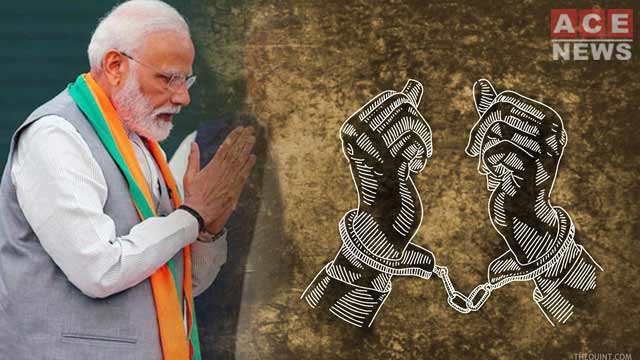Sedition laws have become a handmaid of India’s government under Narendra Modi to stifle dissent, incarcerate political opponents or persecute minorities. Shouting a slogan, wall chalking, social post azadi (liberty), wearing a prayer cap, or offering prayer on adjoining roads when a mosque is overcrowded, could attract sedition charges. Even interfaith marriages or cow-related offences could be tried as sedition. The Hindu-monk chief minister of Uttar Pradesh, Yogi Adityanath, had directed his administration to try cow-related offences under the National Security Act. Some states have passed love-jihad laws to prevent interfaith marriages. The over-ebullient Hindu extremists even haul up such people to the police stations, even though they were happily married long before enactment of the law banning inter-faith marriages.
Till recently, the Supreme Court had looked the other way in cases where there was blatant misapplication of the sedition law. Some verdicts smacked of communal bias. India being a secular country, the Supreme Court should have avoided dabbling in religious matters of different communities, particularly of the largest minority, the Muslims. But, in vain. The Supreme Court pronounced that a mosque was not essential to Muslim way of worship. It allowed demolition of the ancient Babri Mosque. Thus it accepted the fictitious contention that the God Ram was born at the site of the mosque millennia ago.
In marked contrast to its “Islamic” judgments, the Supreme Court had a benign attitude toward the Hindu religion. It admitted that a temple was necessary to the Hindu mode of worship. It allowed menstruating women to visit the Sabarimala temple because of this. Thus while apparently striking down a Hindu authority’s decision, it upheld the faith itself.
India’s Law Commission issued a directive in 2018 that cautioned that a simple expression of a thought inconsistent with the government’s policy did not qualify as “sedition”. One has to be circumspect while invoking the sedition law. Yet, the Commission’s voice has proved to be a voice in the wilderness. Sedition law is a handy tool to stifle dissent. It is hoped that India’s Supreme Court will define the contour of the law more stringently to preclude its misuse by the fanatic Modi government
The plethora of sedition cases awakened the Supreme Court from its slumber. While quashing the sedition case against journalist Vinod Dua, the Supreme Court expressed ennui on the slapping of sedition charges to gag journalists. A Bench of the Supreme Court led by Justice UU Lalit upheld “ the right of every journalist to criticise, even brutally, measures of the government with a view to improving or altering them through legal means”.The case against the journalist had been filed by the ruling BJP and was fervently defended by the Himachal Pradesh state government. The journalist was accused of “criticising the prime minister and the Union government for mishandling of the migrant crisis during the first wave of the Covid-19 pandemic”. The court drew attention to the 1962 Nath case judgment. That judgment took the sting out of the sedition cases filed under Section 124A of the Indian Penal Code. In the aforementioned case, the Supreme Court had ruled that Section 124A of the Indian Penal Code can be used only when someone’s word actually leads to violence or generates an inclination for violence. The Section 124A describes sedition as punishable with imprisonment from three years to life, a fine or both.
Among journalists facing sedition cases is Siddique Kappan based in Kerala. He was arrested by the Uttar Pradesh police while on his way to Hathras to cover a rape case last year and had been denied bail. Kappan and 21 other journalists covering the Hathras rape case were charged under Section 124A.
Similarly, several prominent journalists were charged under the sedition law for their coverage of the farmers’ tractor rally in Delhi on Republic Day. The Supreme Court stayed the arrest of all of them. The Court observed that the Constitution has varying criteria for permissible restrictions on freedom of speech and expression, and draws a boundary between serious and aggravated forms of public disorder which are calculated to endanger the security of the State and the relatively minor breaches of the peace of purely local significance.
India’s Supreme Court had earlier observed in its 1950 judgment on Romesh Thapar versus State of Madras, “Only a higher degree of threat pertaining to endangerment of the foundations of the State could justify curtailment of the rights to freedom of speech and expression,” Thapar was editing a weekly journal called Cross Roads which was constantly at loggerheads with the Congress government of the day.
Disregarding the guidance in this judgment, the successive governments continued to misapply the sedition law.
When the Indian Penal Code was enacted in 1860, the sedition law was not included in it. It took another 10 years for Section 124A to be included. Mahatma Gandhi was tried under this law in 1922. He told the court that the law had malafide intent. It was tailor-made to suppress the liberty of the citizen.
India’s Law Commission issued a directive in 2018 that cautioned that a simple expression of a thought inconsistent with the government’s policy did not qualify as “sedition”. One has to be circumspect while invoking the sedition law. Yet, the Commission’s voice has proved to be a voice in the wilderness. Sedition law is a handy tool to stifle dissent. It is hoped that India’s Supreme Court will define the contour of the law more stringently to preclude its misuse by the fanatic Modi government.
























As usual, Amjed Jaaved is obsessed with Chaiwala and Indian Tea. His tears fail to stop on one Babri Structure, while forgetting thousands of structures of other faiths around the world. He is a confirmed brainless Hindu/ Muslim bamboozle. 😁
Further, as to Mr. Dua, he is an intelligent, seasoned journalist; the FIR against him was not only under section 124A but also included charges for inciting violence and violation under disaster management act. It was a complaint case, wherein, The complainant alleged that Mr. Dua accused PM Modi of using “deaths and terror attacks” to get votes. It was a complaint case by BJP leader Shyam at Kumarsain Police Station in Himachal Pradesh. On HP Police asking him to join the probe in the case he approached the court in May last year. There are thousands of such cases also against BJP leaders and supporters in last 73 years. More glaring is Kangna Ranawat’s case. So the writer’s jumping on it is useless. 😀
Hey Islamic terrorist, enjoy your stay in terror financing get list.